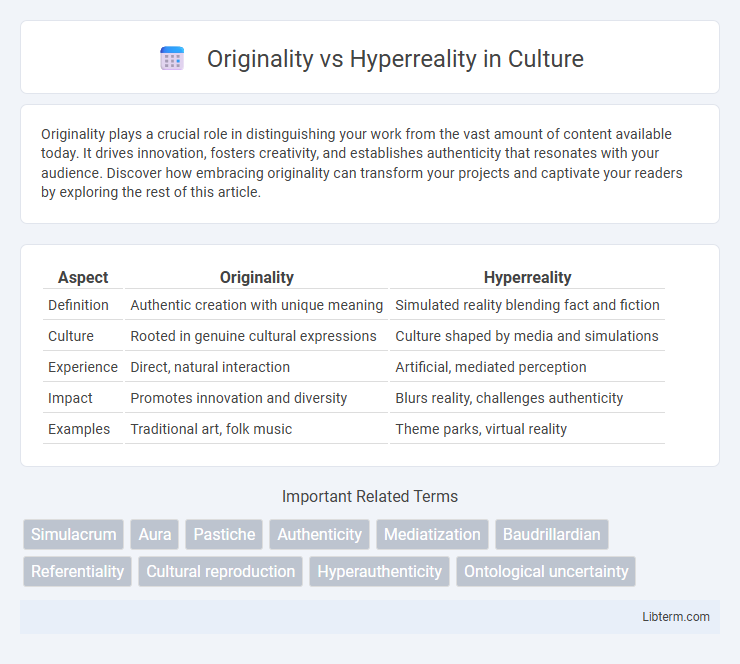Originality plays a crucial role in distinguishing your work from the vast amount of content available today. It drives innovation, fosters creativity, and establishes authenticity that resonates with your audience. Discover how embracing originality can transform your projects and captivate your readers by exploring the rest of this article.
Table of Comparison
| Aspect | Originality | Hyperreality |
|---|---|---|
| Definition | Authentic creation with unique meaning | Simulated reality blending fact and fiction |
| Culture | Rooted in genuine cultural expressions | Culture shaped by media and simulations |
| Experience | Direct, natural interaction | Artificial, mediated perception |
| Impact | Promotes innovation and diversity | Blurs reality, challenges authenticity |
| Examples | Traditional art, folk music | Theme parks, virtual reality |
Understanding Originality in Contemporary Culture
Understanding originality in contemporary culture involves recognizing the tension between authentic creation and hyperreality, where simulated experiences often replace genuine ones. Originality is increasingly defined by unique interpretations and personal narratives that resist mass-produced images and media saturation. This dynamic reflects a broader cultural shift toward valuing distinctiveness amidst pervasive digital reproduction and imitation.
Defining Hyperreality: Beyond the Copy
Hyperreality transcends mere imitation by creating a simulated reality that blurs the line between the original and the replica, often becoming more real than reality itself. It involves the construction of signs and symbols that replace or distort genuine experiences, leading individuals to interact with representations rather than authentic objects or events. This concept challenges traditional notions of originality by suggesting that in a hyperreal environment, the distinction between the original and the copy becomes irrelevant or impossible to discern.
Historical Evolution: From Authenticity to Simulation
The historical evolution of originality to hyperreality traces the shift from authentic, unique cultural artifacts to simulated reproductions that blur reality and representation. Walter Benjamin's concept of the "aura" highlights the loss of authenticity as mechanical reproduction proliferates, enabling copies to replace original works. This transformation reflects Jean Baudrillard's theory where simulacra become detached from any real referent, creating a hyperreal environment dominated by images and signs rather than genuine historical contexts.
The Role of Media in Blurring Reality
Media platforms increasingly blend original content with hyperreal representations, creating environments where distinguishing authentic experiences from constructed narratives becomes challenging. Techniques such as deepfakes, curated social media personas, and sensationalized news amplify hyperreality, distorting public perception and eroding trust in factual information. This convergence emphasizes media's powerful role in shaping a simulated reality that often obscures objective truth and authentic originality.
Art in the Age of Hyperreality
Art in the Age of Hyperreality blurs the line between original creation and simulated experiences, challenging traditional notions of authenticity. Hyperreal artworks often replicate or exaggerate reality to the point where distinction between the real and the artificial becomes unclear. This shift influences artistic value, emphasizing perception and experience over uniqueness or provenance.
Impact of Technology on Perceptions of Originality
Technology has transformed perceptions of originality by enabling the creation of hyperreal replicas that blur the line between authentic and simulated experiences. Digital tools, such as deepfakes and virtual reality, challenge traditional notions of uniqueness by producing indistinguishable copies that question the value of the original. This shift impacts cultural and artistic appreciation, as audiences increasingly engage with mediated realities rather than singular, original artifacts.
Social Media and the Cult of the Simulacrum
Social media platforms amplify the cult of the simulacrum by promoting hyperreality where curated images and experiences replace authentic originality. Users increasingly engage in constructing idealized digital personas, blurring the line between genuine identity and fabricated representation. This phenomenon fosters a landscape where simulated realities often overshadow the nuanced complexity of real-life interactions and originality.
Psychological Effects: Navigating Real and Unreal
Originality in experiences fosters authentic emotional responses and strengthens personal identity, while hyperreality blurs the boundary between genuine and simulated environments, often leading to confusion and detachment. The psychological effects of hyperreality include increased anxiety, identity disorientation, and diminished ability to differentiate reality from artificial constructs. Navigating the interplay between original experiences and hyperreal stimuli requires heightened critical awareness and emotional resilience to maintain mental well-being.
Authentic Experience vs Manufactured Reality
Authentic experience emphasizes genuine, unmediated interactions grounded in reality, fostering personal meaning and emotional depth. Hyperreality blurs the line between reality and simulation, creating manufactured realities that often replace or distort original experiences through media, technology, or curated environments. This tension challenges individuals to discern between true authenticity and constructed narratives in contemporary digital and cultural landscapes.
The Future of Creativity in a Hyperreal World
The future of creativity in a hyperreal world hinges on the balance between originality and hyperreality, where digital simulations increasingly blur the lines between authentic creation and replicated experiences. Advances in virtual reality, augmented reality, and AI-driven content generation challenge traditional notions of originality, demanding new frameworks for evaluating creative value. Embracing hyperreality as a creative tool can unlock unprecedented imaginative potential while preserving the integrity of original artistic expression.
Originality Infographic

 libterm.com
libterm.com